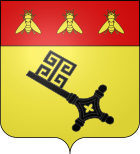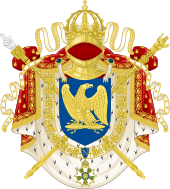Napoleonic heraldry
Under Napoleonic heraldry which launched on March 1, 1808 reorganization of is French arms being understood.
The reorganization was introduced by Emperor Napoleon I with the creation of the new imperial nobility of the First French Empire . According to this new system, the coats of arms should get a new content and symbolize first and foremost national dignity, secondly the dignity of the gender in question . All coats of arms were classified according to the rank and personal dignity of the owner. Another essential, albeit unheraldic, but decisive innovation, such as the omission of the heraldic helmets , characterized this coat of arms period. The helmets were replaced by the chef's hat or a hat decorated with feathers. The lilies , reminiscent of the French kingdom , disappeared from the coats of arms and were replaced by bees . This form of heraldry extended to the coats of arms of the Confederation of the Rhine allied with Napoleon . With the fall of the emperor, the unheraldic system of Napoleonic heraldry ended. It was also used in the later Second Empire of Napoléon III. (1852–1870) not reintroduced.
Napoleonic city herbalism
Another peculiarity of Napoleonic heraldry was the bestowal of special coats of arms on cities. This city heraldry was sometimes extended to the cities annexed to the empire. For example, the cities of Hamburg , Bremen , Cologne , Mainz , Aachen and Geneva carried these new, prescribed coats of arms. Some German city coats of arms were also completely changed, for example Bremen received an overturned black key in the golden field (see Bremer Franzosenzeit ).

The new system classified the cities in three orders.
- First order cities
They were called Good Cities of the French Empire (Bonnes villes de l'Empire français). There were three golden bees in the red head of the shield. Around the shield was a golden wreath braided with red ribbons, made of olive branches on the right and oak branches on the left. On the shield there was a rod of Mercury and above it a high golden wall with a seven-pewter wall crown from which a golden eagle grew.
- Second order cities
In the shield there was a blue right crossing and in it a golden "N" raised by a five-pointed golden star. Above the shield was a rod of Mercury and a high, silver wall crown with five battlements that covered the shield. A silver wreath with blue ribbons was tied around the shield.
- Third order cities
In the shield there was a red left crossing with a silver "N" raised by a five-pointed star. Above the shield was a golden basket filled with golden ears of wheat, on which hung a green wreath of olive branches on the right and oak branches on the left with red flying ribbons.
Napoleonic noble coat of arms
This heraldry was like a classification, especially for the nobility. The upper right and upper left crossing acquired special significance. The former denoted a count in blue, the latter denoted a baron in red. Contrary to the old heraldic rule, the crossing was enlarged or reduced as required. With quartered and cross-cut shields it was a quarter of the shield, with a division by a bar it reached up to this, with shields with a shield head it protruded into this. If the shield contained a sloping beam , the diagonal of the crossing coincided with that of the beam. If there was a common cross in the shield , the crossing did not take up the entire upper quarter. The crossing served to mark the offices of the owner of the coat of arms.
Examples
- Emperor's coat of arms: The emperor wore the imperial crown over his shield adorned with the eagle . Two long golden sceptres crossed behind the shield . The right showed a silver hand as a sign of justice, the left a golden figure depicting the crowned Emperor Charlemagne with a scepter and orb .
- Coat of arms v Joachim Murat: This coat of arms of Joachim Murat as Grand Duke of Berg (r. 1806–1808) was a Napoleonic creation. It showed a silver double anchor in the silver-red split shield (he was also Grand Admiral of the French Empire). To the right of the center of the anchor walked a red lion (for Berg), to the left was the lily scepter star (for Cleves), and in the center of the anchor was a blue heart shield with a golden eagle on a thunderbolt (for the Grand Duke). The crest. was enclosed by the chain of the Grand Cross of the Order of the Legion of Honor. On the coat of arms covered with golden bees, two crossed marshal's baton.
- Prince-dignitaries received black velvet hats with red-gold iron hats instead of crowns . There was a gold holder with seven fan-shaped, white, curved feathers on the cap. The coats of arms of this rank received a blue shield head, which was studded with soaring golden bees. The coats of arms were surrounded by a blue, hermelin- lined cloak studded with golden bees, which was held up by a hermelin-clad blue cap (bonnet d'honneur) similar to the electoral hat .
- The newly appointed dukes of the empire wore a cap like the prince-grand dignitaries, but this had an ermine lapel. The coats of arms contained a red shield head studded with five-pointed silver stars. The blue coat of arms was lined below with white iron hats.
- The count-senators wore a black velvet cap with an ermine cuff and five feathers.
- Count-archbishops ran the same way as count-senators, but with a surcharge of counter-hermelin and a golden agraffe with five feathers. Over these coats of arms a red, broad-brimmed hat with silk cords of the same color that ended in five tassels on both sides of the shield.
- The count military officers used the previous cap, the barons military officers likewise, but with a premium from Gegenfeh (Eisenhütlein).
- Barons-bishops wore a similar cap. Above their coat of arms was a broad-brimmed green hat with four green tassels each. Above the coat of arms of the Knights of the Legion of Honor was a black cap with a green lapel and a white plume. The sign of the order appeared in various places in the shield, often on a red pole .
- Count without special status or holder of the Grand Cross of the Order of the Legion of Honor: simple blue right crossing. The counts of the empire wore a black, iron hat with a gold-bordered chef's hat over their coat of arms, around which a gold circlet with an agraffe with five silver ostrich feathers was placed. From the cap emerged golden arabesques resembling a helmet cover. The coat of arms was surrounded by a yellow-lined blue coat.
- Graf-Senator: blue right crossing, in which there was an oval, gold-framed hand mirror. The handle of the mirror was surrounded by a snake flickering to the right .
- Graf-Minister: blue right crossing with red-tongued, golden lion's body turned to the right.
- Graf-Staatsrat: blue right crossing, gold and blue dice.
- Earl-President of the Legislative Body: blue right crossing with the golden tablets of the Law of Moses.
- Graf-Archbishop blue right crossing with gold paw cross touching the edges .
- Graf military: blue right crossing with an upright, silver and gold-edged sword.
- Count house officer of the emperor: blue right crossing with two golden pillars standing on a pedestal , above a pointed roof. A golden “D” on the right of the pillars, a golden “A” on the left.
- Count house officer of the imperial princes: as with the emperor's house officer, but the letters "D" and "J" within the pillars.
- Graf-Minister in the foreign service: blue right crossing with a silver lion's trunk.
- Graf Prefect. blue right crossing with golden wall, above a golden oak branch.
- Graf-Maire: as with Graf-Prefect, but without an oak branch.
- Count-President of the electoral college: blue right crossing with three side-by-side, golden, upright awakenings symbolizing the ballot papers.
- Graf member of the electoral college: blue right crossing with a golden oak branch slanted to the right.
- Graf landowners: blue right crossing with upright golden ear.
- Baron without special office: upper left crossing in red tincture . The barons of the empire wore a black chef's hat with a silver-bordered cuff that was decorated with five silver stars over their coat of arms. A silver clasp with three ostrich feathers was attached to the forend. Framing silver arabesques emerged from the cap .
- Baron-Bishop: red left crossing with a floating, silver, common cross.
- Baron-Military: red left crossing with a right silver sword with a golden hilt.
- Baron officer of the imperial house: red left crossing, therein symbol as with the count house officer of the emperor, but silver.
- Baron-Minister in Foreign Service: red left crossing with a silver lion's trunk.
- Baron house officer of the imperial prince: as with Graf house officer, but in a red crossing on the left.
- Baron member of the Council of State: red left crossing, made of red and gold or yellow.
- Baron-President and Baron-General Procurator of the House of Cassation: red left crossing with silver scales.
- Baron-President and Baron-General Procurator of the Imperial Court: red left crossing with black, Hermelin-trimmed procurator's hat.
- Baron medical officer of the army: red left crossing with a silver sword plunging to the left.
- Baron-President of the electoral college: red left crossing with three stake, silver, diamond-shaped ballot papers.
- Baron-Prefect: red left crossing with a silver wall, above a silver oak branch.
- Baron sub-prefect: red left crossing with a silver, richly fertilized oak branch.
- Baron-Maire: red left crossing with silver wall.
- Baron member of the electoral college: red left crossing with a silver oak branch slanted to the right.
- Baron member of the medical corps: red left crossing with an oblique, silver palm branch.
- Baron landowners: red left crossing with an upright silver ear.
- Scholar: red left crossing with a silver palm branch.
See also
Web links
- private page Graphic examples of Napoleonic heraldry (PDF file; 246 kB)
literature
- H. Simon: Armorial general de l'Empire francois. Paris 1812.
- M. Gritzner : Handbook of heraldic terminology. (Introductory volume to the New Screen Maker, Section A). Nuremberg 1890.
- Gert Oswald : Lexicon of Heraldry. Bibliographical Institute, Leipzig 1984.
- Milan boys : heraldry. Albatros, Prague 1987.
- Walter Leonhard : The great book of heraldic art. Callwey, Munich 2001, ISBN 3-8289-0768-7 .



